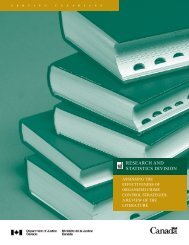National Threat Assessment 2008. Organised Crime - Politie
National Threat Assessment 2008. Organised Crime - Politie
National Threat Assessment 2008. Organised Crime - Politie
Create successful ePaper yourself
Turn your PDF publications into a flip-book with our unique Google optimized e-Paper software.
The commercial production of images of child abuse mostly involves organised<br />
criminal groups, as far as we know mainly from countries in the former Soviet<br />
Union, such as the Ukraine and Belarus, and other countries from the former<br />
Eastern Bloc. Production takes place in the countries of origin of these<br />
organisations and local children are abused. The children are often runaways living<br />
on the streets or they come from children’s homes, and they vary in age from 2 to<br />
14. The distribution of the images of abuse is also controlled from abroad.<br />
The scale of commercial production is unknown, but it is clear that it generates<br />
a great deal of money. The United Nations reported on a worldwide<br />
investigation in 2006 that criminal profits of 6 billion dollars were generated.<br />
Non-commercial production of images of child abuse involves images of child<br />
abuse by individuals, usually by relatives and acquaintances of the victim’s family.<br />
Victims are also recruited under false pretences (this is known as ‘grooming’).<br />
There are many possibilities for grooming on the Internet; contact can easily be<br />
made via chatboxes, for example. The abusers pay attention to the children and<br />
sometimes give them presents, with the ultimate aim of sexually abusing them.<br />
There is no commercial purpose in these cases. However, the material is often<br />
distributed online, mainly by exchanging it for other material. This form of<br />
non‐commercial production is also found among sex tourists, who make<br />
recordings with their digital cameras in countries with limited monitoring, such<br />
as Thailand or Cambodia.<br />
The scale of the non-commercial production of images of child abuse is difficult<br />
to determine. The investigating authorities often fail to reach the source. The<br />
relationship with the Netherlands or Dutch nationals is also difficult to establish.<br />
Distribution of images of child abuse<br />
The production of and distribution of images of child abuse tend to go<br />
together, although the driving forces are not always the same. The Internet is<br />
an important medium for distribution among the target group. The consumers<br />
are usually very well aware of the fact that their sexual values are deviant and<br />
they use the possibilities offered by the Internet to remain anonymous.<br />
The IPOL document reports four types of distribution of images of child abuse<br />
on the Internet:<br />
1. Peer to peer<br />
In the publicly accessible sections of the Internet you can still find people who<br />
download images and distribute them independently. Some of these people use<br />
so-called ‘peer-to-peer’ programs such as Kazaa to exchange images. These<br />
cases do not involve distribution for commercial purposes.<br />
86 <strong>National</strong> <strong>Threat</strong> <strong>Assessment</strong> 2008 – <strong>Organised</strong> crime








